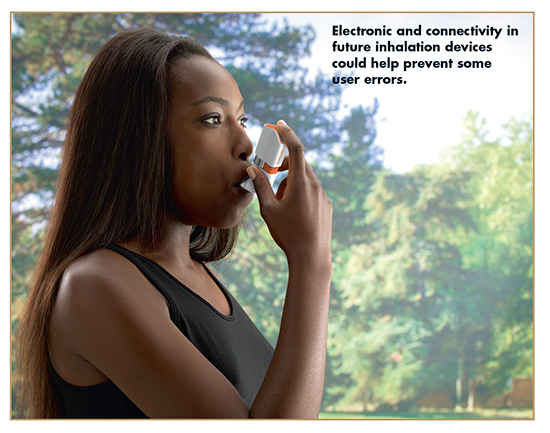Issue:April 2019
SMART DEVICES - Add-On Connectivity Facilitates New Generation of Smart Inhalers
INTRODUCTION
The addition of electronic and connectivity to inhalers may improve patient adherence and, consequently, treatment efficacy. This conclusion was unanimously reached by a panel of experts participating in a recent roundtable discussion hosted by Nemera, a France-based designer, developer, and manufacturer of drug delivery devices.
The global connected drug delivery device market is expected to reach $717.7 million by 2025, according to a recent report.1 Factors contributing to this growth include increased awareness of the adverse effects of non-adherence to medication and increased adoption of connectivity with patient engagement. Analysts claim that leading manufacturers of connected drug delivery devices are collaborating with software companies to assess the feasibility of cloud data system in their devices. No group is more indicative of this trend than inhaler manufacturers, who are racing to develop a new generation of smart devices with sensors to ensure that patients with asthma and chronic lung disease are using their devices properly.2
COMMON INHALER MISTAKES
Rescue inhalers that deliver short-acting bronchodilators to relieve sudden respiratory symptoms, and maintenance inhalers that deliver long-acting bronchodilators and corticosteroids to prevent and control respiratory symptoms, are the cornerstone of managing asthma and COPD. Inhalation devices that deliver these medications are available in these basic types:
-Pressurized metered-dose inhalers (pMDIs) consist of an aluminum canister of medication fitted into a plastic body with a mouthpiece. Each dose is delivered by pressing the canister into the plastic body while inhaling through the mouthpiece. Use of a spacer that connects to the MDI removes the need for coordination between inhalation and activation of the device; formulation is first released into the spacer and then inhaled slowly.
-Dry-powder inhalers (DPIs) can be preloaded with the medication(s) inside the device or be loaded by the patient with capsules as the dose-holding system prior to use. A single dose of the medication is loaded and ready to be inhaled, for example, by sliding a lever, twisting a part of the device or, in the case of capsule devices, pressing buttons to pierce the capsule. Patients simply take a deep breath while their lips are sealed around the mouthpiece of the inhaler, and the dose is delivered.
-Soft mist inhalers are a propellant-free liquid inhaler that provides a slow-moving, soft aerosol cloud of medicine to help patients inhale. In comparison with a pMDI, they reduce mouth deposition and generate a “mist of droplets” lasting longer than the Pmdi aerosol.
-Nebulizers change medication from a liquid to a cloud of medicine that can last up to 15 minutes. They are used to deliver large doses of drug.
While the correct use of an inhaler depends on the type, at least 70% – and some studies indicate upward of 94% – of patient inhaler users make at least one mistake using their inhaler, resulting in no drug delivered or diminished drug delivered, and potential exacerbation of respiratory symptoms.2 Mistakes include the following:
-Dose preparation errors – In the case of an MDI, the patient may not shake the canister before each dose or may exhale while actuating the device. In the case of a DPI, the patient may fail to load a dose at all. Or, if a DPI requires piercing a capsule, the patient may not pierce the capsule and may not use a new capsule for each dose.
-Improperly using the device – For example, the patient may fail to remove the cap of the inhaler.
-Improperly holding the device – In some cases, it is not uncommon for the patient to hold the device sideways or at an incorrect angle. If the dose, to be properly loaded or delivered, needs the device to be held in a certain position, it may be incompletely delivered or not delivered at all.
-Inhalation errors – Issues include breath coordination and depth of breath. Patient fails to: exhale fully and away prior to inhalation; inhale slowly and deeply; or hold their breath for a full 5 to 10 seconds.
TYPES OF ELECTRONIC DEVICES
While newer inhalers have design features to remedy these errors, such as dose counters, incorrect use continues to be prominent. “Devices today do not have sufficient capability to provide the patient user with feedback, which is why some mistakes are made,” says Nemera’s Global Category Manager – Inhalation & Dermal, Raphaële Audibert, who was part of the roundtable discussion. “But, we know that some mistakes can be avoided, and electronic devices are a great way to reduce or eliminate those errors.” Electronic devices can be:
-Non-connected devices with different possible features, such as on-device feedback to patient (for example through LED, voice, or screen) or automatic actuation of a device once certain parameters are addressed; and
-Connected devices to enable richer feedback to patients or communication with doctors.

A connected device, such as an inhaler, is connected to a smartphone app or a website to communicate with the patient. This may include sending reminders to take medication and providing usage feedback. This information can also be sent to the patient’s doctor to monitor patient adherence and treatment efficacy. Ms. Audibert says the doctor can then determine, in the case of unsuccessful treatment, if it is due to an absence of patient response to a specific drug, if the treatment was not taken as prescribed, or if the patient exhibited poor inhalation techniques, at which point corrective action can be taken.
Electronic drug delivery systems are categorized as either add-ons or integrated devices. Both options have distinct advantages and disadvantages, with both being widespread in development projects throughout the pulmonary spaces. Sensors mechanical devices and providing tracking and usage information.
“Devices with add-on sensors can record how, when, and where the mechanical activation of a device took place,” says Hadrien Gremillet, Strategic Marketing Analyst, Nemera. “These devices will usually provide feedback after administration of the drug, and in some cases, give real-time feedback prior to the administration, such as positioning.”
Integrated devices go one step further by enabling, for example, electronic-driven actuation of the device that can be then coordinated with a breath. Adding electronic connectivity requires a printed circuit board (PCB) containing a micro controller and sensors, such as an accelerometer or microcontroller. The integrated device connects to a mobile application or to the cloud via the use of wireless communication elements such as Bluetooth or LTE-M.
CONCEPT DEVICES PROVE CONNECTIVITY IS TRANSFERRABLE
Connectivity is possible with all types of inhalation devices. A few players are already demonstrating their technical capabilities to build such devices. For example, Nemera’s knowledge in development, manufacturing, and innovation has resulted in a few concept devices that showcase how electronic features are transferrable across multiple platforms, such as inhalers. One of these concept devices is the e-Novelia®, a smart add-on device for the established Novelia eyedropper.
Electronic features include: tilt sensor and LED indication for device positioning; location tracking; remaining drug indicator; electronic instructions for use (IFU); drop detection; and Bluetooth communication. According to Mr. Gremillet, e-Novelia uses sensors to detect, for example, when the incline of the device is correct, and signals this to the patient via a green light. Digital readouts provide feedback about dosing and remaining medication. And communication with a smartphone app enables medication reminders, and ultimately, patient adherence.
The second concept device from Nemera is e-Advancia®, a reusable, rechargeable add-on device for an established product. Combined with the Advancia® high-performance pump, the add-on features shaking sensors, a display, reminders, dose counter, posology indication, and a connected app.
“For pharmaceutical companies interested in electronic-enhanced devices, we can integrate all our know-how about electronic/connectivity into a specific inhalation project as part of the features obtained are also of interest for inhalation,” he says.
THE COSTS OF COMPLIANCE
In a world where hacking exists, users should take steps to secure the connection from the device to the smartphone, from the device to the cloud, the smartphone app, and the cloud itself. Mr. Gremillet says that Nemera has internal experts to provide guidance and support to protect data generated by using electronic devices, which includes specific cloud architectures among other things.
In addition to hacking, device makers are cautious about the price of connectivity. The add-on segment accounted for 72.6% of the connected drug delivery devices market in 2017 and are considered more cost-effective than their integrated counterparts. Moreover, the cost of switching from a conventional system to add-on sensors is relatively low.1
Mr. Gremillet says electronics can add costs to the initial mechanical device. However, note that electronic devices are reusable, which spreads the overall cost over many administrations. Additionally, considering the entire treatment path of a patient, electronics can decrease the overall disease cost by limiting costly events, such as hospitalizations. “Device manufacturers, pharma companies, and payers should evolve their business models to consider those decreased hospitalization costs and not just consider the price of the electronics. One cannot quantify improved patient compliance.”
REFERENCES
- Connected Drug Delivery Devices Market Worth $717.7 Million By 2025, Grand View Research, December 2018, https://www.grandviewresearch.com/press-release/global-connected-drugdelivery-devices-market.
- Correct Use of Inhalers: Help Patients Breathe Easier, Institute for Safe Medication Practices, July 14, 2016, https://www.ismp.org/resources/correct-use-inhalers-help-patients-breathe-easier.

Cindy H. Dubin is an award-winning journalist who has been reporting on the pharmaceutical industry for more than 18 years about a variety of topics, including formulation development, drug delivery, and drug quality.
Total Page Views: 5785










